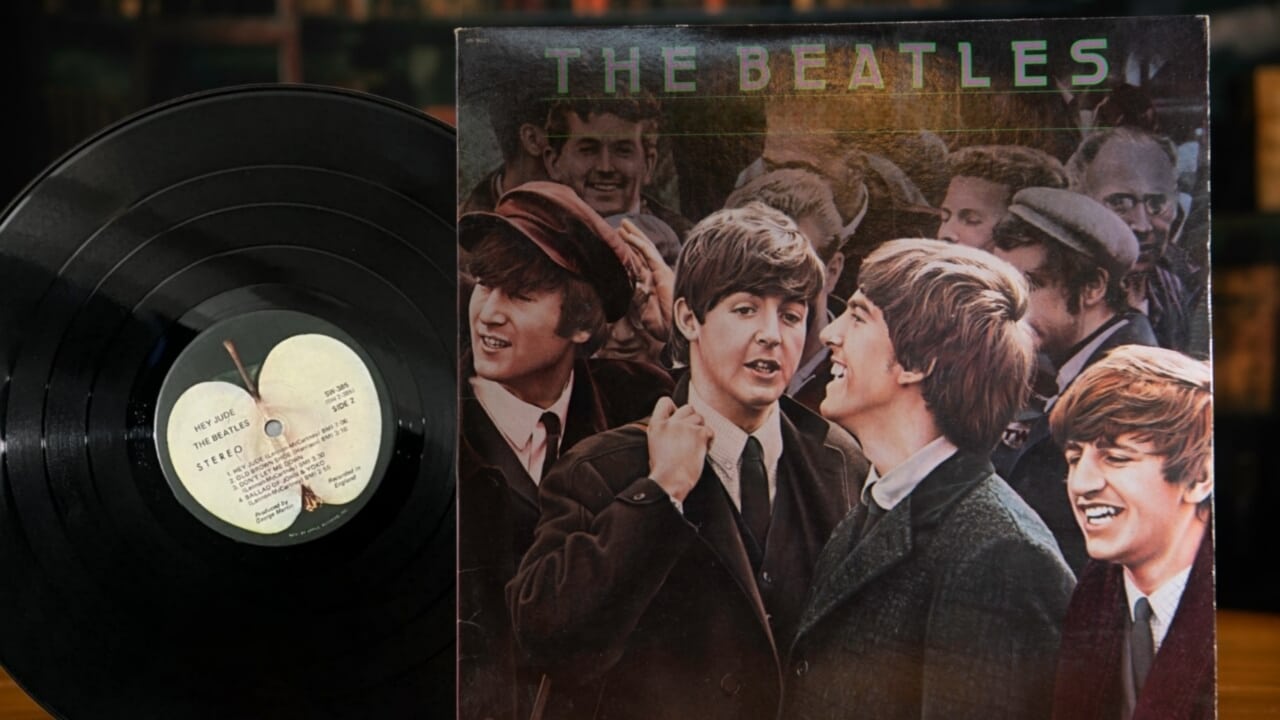33 ’60s Songs The World Will Never Forget

To everything, we turn, turn, turn the pages out of respect for living with the current times. New tunes come out every day, and the times are always a-changin’.
Wouldn’t it be nice to look back at some classic good vibrations that seem to twist and shout along the grapevine, though? After all, many songs today are molded by all the chained melodies of the past. Marvin Gaye, the Beach Boys, Elvis, and many other believers of majestic chimes are responsible for plenty of threads in today’s music.
Don’t mind us if we’re dancing in the street to some of these legendary ’60s jams. Some ooze flower power themes, and some can’t help but fall in love with certain rock stars. Ready for a gas?
The Twist

Come on, baby, let’s do “The Twist” and check back into Chubby Checker’s 1960 pop hit. This boss track delivers everything folks remember about the 1960s: twistin’ dance moves, groovy lyrics, and American Bandstand prominence. The South Carolina-born singer sang on other tracks, yet “The Twist” is arguably his most famous tune.
Though Hank Ballard and the Midnighters originally wrote “The Twist” composition, Checker’s version is well-known by practically everyone. It continuously appears in pop culture and hangs on Billboard’s “Greatest of All Time Hot 100 Songs” as the number two track.
I’m a Believer

“The Twist” isn’t the only ’60s track appearing on the aforementioned Billboard list. The Monkees’ “I’m a Believer” stands at position 69. With lyrics by Neil Diamond, “I’m a Believer” expresses finding love against doubtful fantasies. While Diamond found some success with his version, the 1966 Monkees shot the song into unreal territory.
With regards to a particular Smash Mouth cover, “I’m a Believer” remains a worldwide favorite. Countries like Germany, Italy, Norway, Canada, and so many others get all jazzed up whenever the track plays. Other covers come into play, yet the original Monkees version is the beat many look to when remixing the composition.
I Heard It Through the Grapevine

The “Greatest of All Time Hot 100 Songs” list includes a pleasant Marvin Gaye classic from 1968. It’s the last one we’ll reference from the list since it gathers newer tunes, yet “I Heard It Through the Grapevine” is simply timeless. The original release comes from Gladys Knight & the Pips, though Gaye delivered the more famous rendition.
Filled with Motown harmony, “I Heard It Through the Grapevine” is one the 1960s most recognizable ditties. Rolling Stone includes Gaye’s song on its “500 Greatest Songs of All Time” 2024 list at rank 119.
If we were going to be told about our lover’s infidelity, we’d want Gaye to inform us.
Happy Together

We must always draw away the curtains to welcome in the morning sunshine whenever the Turtles’ “Happy Together” plays. The 1967 psychedelic pop hit speaks on foreseeable love, supported by a twitchin’ chorus that gets any crowd moving. Just look at any of the many films and television shows featuring the famous Turtles tune.
Compared to other songs from the Turtles, “Happy Together” remains their most significant delivery. Countries around the world celebrate its inclusion in music history, from Australia and Norway to the lands of Canada.
Like the seasons, we’re so “Happy Together” whenever the lead guitar breaks into the track.
White Rabbit

One fantastic entry into the world of psychedelia involves Jefferson Airplane’s “White Rabbit” acidic drop. The 1966-67 track takes a few images from Lewis Carroll’s books featuring Alice’s adventures from Wonderland. Talking men on chessboards, hookah-smoking caterpillars, magic mushrooms — “White Rabbit” takes the listener down an exciting trip.
While global charts don’t sing high to the heavens with “White Rabbit,” its pop culture presence remains omnipresent. Stranger Things, Fear and Loathing in Las Vegas, Platoon, The Simpsons, and many others have incorporated the essence of Alice.
However, we also sense that some folks are more familiar with “Somebody to Love”; both songs come from the Surrealistic Pillow album.
Brown Eyed Girl

Van Morrison, The Belfast Cowboy himself, wrote the lyrics for “Brown Eyed Girl” in 1967, and it hasn’t left mainstream audiences since. With such a catchy rhythm, Morrison offers his vocals that speak on time and love. “Do you remember when/We used to sing?” Morrison famously expresses before breaking into the “sha-la-la-la” portion of the song.
One glance at “Brown Eyed Girl” current stats shows that folks still jam along today. It’s fitting for any summer drive or a dip in the pool, and its vibrant chorus powers enough fuel to keep any party afloat.
My Girl

“Brown Eyed Girl” is one of the few songs selected for The Big Chill soundtrack. The 1983 comedy-drama by Lawrence Kasdan revolves around a group of friends reuniting after a particular tragedy. It stars actors like Jeff Goldblum, Tom Berenger, and Glenn Close, yet we tend to replay the soundtrack more, which includes “My Girl” by The Temptations.
The 1964 soul-sizzlin’ song from Smokey Robinson and Ronald White helped spread the Temptation message across the globe. More than 200 artists have produced “My Girl” covers, making it one of the most covered songs musicians look to for inspiration.
Dancing in the Street

Marvin Gaye, William Stevenson, and Ivy Jo Hunter assembled to write “Dancing in the Street” to give Motown a different vibe. The song was initially released in 1964 with the Martha and the Vandellas version, yet others famously exist. The Kinks with their 1965 iteration; Van Halen attached a cover for their Diver Down album; Mick Jagger and David Bowie did…something with theirs.
No matter which version you listen to, “Dancing in the Street” reaches out to the entire world. “Callin’ out around the world/Are you ready for a brand new beat?” the opening lyrics express, inviting everyone to dance.
Good Vibrations

Looking at many of The Beach Boys’ hits from the 20th century reminds us of the timeless classics the group delivered. “Wouldn’t It Be Nice” and “Surfin’ U.S.A.” are practically eternal in music’s evolution, yet we believe “Good Vibrations” from 1966 stands as their biggest song. Global charts note its dominance over other Beach Boys tunes, so it’s only natural.
“I’m pickin’ up good vibrations/She’s giving me excitations,” the Beach Boys chant in the sunshine pop’s resounding chorus. It’s a line everyone recognizes, possibly because its composition scientifically makes people happy. We’re not kidding; “Good Vibrations” is meant to bring a smile to your face, scientifically speaking.
Sweet Caroline

Neil Diamond’s “Sweet Caroline” is another crowd-pleaser that unites any crowd. The American singer-songwriter wrote and released the song in 1969, and it hasn’t left peoples’ ears since. Of course, Diamond perked many ears with other songs, too, but “Sweet Caroline” and its exciting chorus connect everyone in the room.
We’ve seen “Sweet Caroline” attached to commercials, television shows, and bar playlists. Sporting events even include Diamond‘s track as a victory song, knowing its public impact by instilling a chant everyone can join in on.
The Wanderer

Doo-wop songs are everlasting compositions of happiness we can never get tired of. The genre introduced many fans to Dion and his musical associates, like the Del-Satins and the Belmonts. One such tune from the singer many know and snap their fingers to is “The Wanderer” from 1961. It joined the Runaround Sue album that same year, which features the “Runaround Sue” number one hit.
Both tracks appear on multiple music charts, yet “The Wanderer” statistically stands above “Runaround Sue.” We enjoy both, though we’re inclined to find an establishment playing “The Wanderer” over the other doo-wop classic.
Unchained Melody

Far too many songs revolve around chained melodies, and the aptly-titled “Unchained Melody” features one. Initially created by Alex North and Hy Zaret for the 1955 Unchained film, the “Unchained Melody” tune didn’t reach broader audiences until the Righteous Brothers covered it. Their version appeared a decade after the song’s 1955 inception, and it’s one that many stick with.
“Unchained Melody” may originally go with the 1955 prison film, but many moviegoers connect the song with Ghost from 1990. This transcends the music from one generation to the next, and we see its run continuing for a while.
Can’t Help Falling in Love

Soundtrack albums are a dime a dozen, and Elvis Presley dabbled in plenty of compositions. One album critics and fans collectively recognize is Elvis’ Blue Hawaii album from 1961. While the film Blue Hawaii garnered a mixed reception, Elvis sang “Can’t Help Falling in Love,” and the world did just that.
“Can’t Help Falling in Love” struck the heartstrings of fans from around the world. Other versions exist, but UB40’s arrangement charted over Elvis’ original version with additional listeners. Who knows, maybe mixing reggae and messages of love really do go hand-in-hand.
Hey Jude

Almost any song from the Beatles’ discography in the 1960s became a global hit. It’s difficult picking just one, with hits like “Let it Be” and “Yesterday” sticking out. However, we remember their “Hey Jude” sound as their biggest song.
Hundreds of versions co-exist alongside the original Beatles tune from 1968. These covers go international, ensuring that every corner of the Earth knows about John Lennon’s martial issues.
Alternatively, “Here Comes the Sun” is a close second. Still, nothing beats that euphoric “Na-na-na na” refrain from “Hey Jude.”
(I Can’t Get No) Satisfaction

Beatles or Stones – which is better? Both bands are often compared with each other, but we adore the sounds of both groups. For the Rolling Stones, folks can’t get enough of “(I Can’t Get No) Satisfaction” from 1965.
Not only is “(I Can’t Get No) Satisfaction” an instant ’60s gem, but it’s also incredibly popular beyond its initial U.S. distribution. Countries worldwide play the Stones classic on repeat, as the song features a far-out hook that’ll shake any bedposts. It gets the doves and hawks all hot and bothered, and we gladly thank Mick Jagger’s alluring vocals for the assist.
Like a Rolling Stone

Surely, the times are a-changin’, but don’t call us Shirley when we highlight Bob Dylan’s “Like a Rolling Stone” over his societal anthem. The folkster recorded and released “Like a Rolling Stone” in 1965, and it flipped the music industry on its head. Dylan evolved from a known folk singer to a revolutionary rock poet with one song.
Rolling Stone (the magazine) recognizes Dylan’s track as the number four tune on its “500 Greatest Songs of All Time” list. Dylan made a statement with “Like a Rolling Stone,” and the message still sings today.
Additionally, musicians continuously rediscover “Blowin’ in the Wind” and deliver new versions for modern listeners.
A Change Is Gonna Come

Speaking of anthems, Sam Cooke propelled certain angles during the Civil Rights Movement in the 1960s. Through his music, folks connected with specific struggles, and nothing shouts louder than “A Change Is Gonna Come” from 1964.
Given today’s climate, Cooke’s critical hit against racial tensions still resonates with current issues. Many artists have recorded “A Change Is Gonna Come” versions, highlighting its cultural significance decades after Cooke’s original pressing. The previously mentioned Rolling Stone list places Cooke’s song at number three; Public Enemy’s “Fight the Power” follows up at number two, and who couldn’t ask for a better pairing?
Respect

Though Dylan held the number one position for some time, Aretha Franklin took over with her “Respect” theme. Originally written by Otis Redding in 1965, “Respect” became Franklin’s signature song that encourages woman power to the max. Her version premiered two years after Redding’s track, yet it’s inarguably the more sought-after iteration of the rhythm and blues classic.
Though Hollywood depends on “Respect” for audience familiarity, Franklin’s version lives on as a feminist anthem. By changing lives, Franklin, in turn, changes the world with a straightforward message: “R-E-S-P-E-C-T/Find out what it means to me.”
Sock it to me, sock it to me, sock it to me.
Reach Out (I’ll Be There)

It’s important that we remind our lovers of our undying support, so we look to the Four Tops for inspiration. Any Four Tops ditty stands beautifully with a bouquet of roses, yet their “Reach Out (I’ll Be There)” hit really gets the message across. This 1966 gem comes from the Holland–Dozier–Holland production team, who oversaw many Motown tracks.
“Reach Out (I’ll Be There)” serves as another standard for music artists to cover. Most notably, Diana Ross and Gloria Gaynor made their versions after the original Four Tops. Other covers exist, yet we also jam out to several international iterations that bake different listening experiences.
Bad Moon Rising

John Fogerty composed plenty of rock hits, and it’s difficult to highlight just one. “Fortunate Son,” Proud Mary,” “Green River,” and “Have You Ever Seen the Rain” stand as some of his best work. However, his “Bad Moon Rising” sound with Creedence Clearwater Revival from 1969 produces that familiar anti-war theme we all know and love.
The song’s opening guitar riff introduces any listener to friendly territory, marked with a charming chorus. “Don’t go around tonight/Well, it’s bound to take your life/There’s a bad moon on the rise,” the lyrics read, a stanza multiple artists covered from Fogerty’s words.
(Sittin’ On) The Dock of the Bay

Otis Redding and Steve Cropper recorded “(Sittin’ On) The Dock of the Bay” in 1967 before the singer passed away. Cropper painted the final touches with the song’s mixing the following year, mainly regarding the wavy sound effects. Though Redding desired the waves, Cropper fulfilled the singer’s request after his death.
The results conjure an immortal tune with “(Sittin’ On) The Dock of the Bay” to which many folks sway. On top of its global appeal, Redding’s song attracted listeners overseas. Its beautiful composition lends a blueprint for any musician to replicate and adapt to a different delivery.
Stand by Me

While many musicians remix Otis Redding’s sounds into new compositions, the world will never forget “Stand by Me” and its impact on entertainment. Ben E. King, Jerry Leiber, and Mike Stoller wrote and produced the song in 1960-1961. Folks immediately played “Stand by Me” on repeat when it first released, but that’s just a taste.
“Stand by Me” served as the theme song for the 1986 Rob Reiner film of the same name. More than 400 artists covered the song since its 1961 release. The Playing for Change project utilizes King’s song as a thematic attachment. In other words, the song’s omnipresent power is here to stay.
Mrs. Robinson

Here’s to you for remembering the 1968 Simon & Garfunkel single fans know as the theme for 1967’s The Graduate. The strong folk duo wrote other tunes for the Mike Nichols-directed film, yet “Mrs. Robinson” became its most recognizable number.
“Mrs. Robinson” also stands as one of Simon & Garfunkel’s most successful strains. Though songs like “The Sound of Silence” and “Bridge Over Troubled Water” received a more significant reception, “Mrs. Robinson” adds a sense of familiarity for moviegoers and music fanatics alike. Unlike other Simon & Garfunkel collaborations, the chart-topping folk rock for The Graduate remains forever in our twisted hearts.
Oh, Pretty Woman

Mrs. Robinson may be seductive, yet we all take turns eyeing our old ladies whenever “Oh, Pretty Woman” plays on. Written by Roy Orbison and Bill Dees, the 1964 rock-country bop becomes distinguishable with the swingin’ ’60s decade. Desire and infatuation compact the soothing lyrics into a memorable hook the world knows by a note.
Whether it’s the addicting guitar riff or Orbison’s yearning vocals, “Oh, Pretty Woman” gives any listener the power to envision passion. The 1990 Pretty Woman film with Julia Roberts and Richard Gere greatly reinstalled the music in many folks’ ears. Some like to replay The 2 Live Crew version for a dirtier interpretation.
Turn, Turn, Turn

The 1960s produced so many guitar riffs that musicians today look back on and sample into new material. One song that delivers such a riff is the Byrds’ “Turn, Turn, Turn” single from 1965. The lyrics speak of peace and war, time and love, hope and loss — all critical to the flower power friends of the decade.
However, its peaceful anthem became more than a supportive arm for the free-spirited followers. “Turn, Turn, Turn” climbed music charts and critics, becoming a pop hit. Over their other hits, “Turn, Turn, Turn” remains their most played. In the Netherlands, France, South Africa, and everywhere else, to everything there is a season.
California Dreamin’

All the leaves are brown when seasons shift later in the year, though we always look forward to warmer days. With this in mind, it’s important that “California Dreamin'” remains on our playlists. Of course, the Mamas & the Papas wonderfully administered their single in 1965, yet the song’s presence stays awake with the rest of the world.
Over 300 “California Dreamin'” covers exist, and they usually use the Mamas & the Papas version over the original Barry McGuire experience. It’s the choir portion that gets the crowd moving and its focused imagery of a hot day in Los Angeles.
Raindrops Keep Fallin’ On My Head

The world is brutal, but we instantly feel a little better whenever we play “Raindrops Keep Fallin’ On My Head.” Burt Bacharach and Hal David wrote the lyrics in 1969 for the Butch Cassidy and the Sundance Kid film. Like other songs that attach specific films, “Raindrops Keep Fallin’ On My Head” saw continued success after its cinematic debut.
At the time of writing, 461 “Raindrops Keep Fallin’ On My Head” covers are available for the public to listen to. The list is quite extensive, yet it highlights the international versions. It further showcases the song’s immortal impact for all generations to become familiar with.
These Boots Are Made for Walkin’

Infusing pop and country elements into “These Boots Are Made for Walkin’” creates an infectious sound. Nancy Sinatra did just that; the 1965 song became her signature tune.
Indeed, “These Boots Are Made for Walkin'” is another widely-covered song, and it’s appeared in other media. Films like Full Metal Jacket, Austin Powers: International Man of Mystery, and Cruella use the song to an engaging degree. It’s a fierce tune that drives into a fantastic instrumental breakdown we can’t help but dance to.
My Way

In terms of tunes that the world will never forget, Frank Sinatra’s “My Way” is high on the list. The song comes from the French “Comme d’habitude” music, which Paul Anka adapted into English for Ol’ Blue Eyes. Sinatra set the standard for the delivery of newer compositions, and the world hasn’t been the same since its 1969 release.
From hundreds of covers to numerous appearances in other media, “My Way” is a song everyone knows. Not only do Sinatra fans mark it as one of his best songs, but it also sets a decent framework many can emulate.
Knock on Wood

Eddie Floyd and Steve Cropper assembled to write the lyrics for “Knock on Wood” in 1966, creating a new sound for the Alabama-born singer. From there, the song found new homes with artists like Otis Redding and David Bowie, though many exist for any genre-hungry enthusiast.
The one version many remember and replay is Amii Stewart’s version from 1979. Though more than a decade apart, the lyrics are now etched into our ears.
I Want You Back

The Jackson 5’s music is one section of entertainment we look fondly at. Songs like “I’ll Be There” and “ABC” will never escape our interests, but it’s “I Want You Back” that became their biggest hit on the charts. The pop bop was released in 1969, and the decade is definitely not getting it back.
In addition to its American appeal, “I Want You Back” reaches international audiences and artists, too. Cleopatra recorded their version in 1998, while Twice launched theirs in 2018. “I Want You Back” is here to stay despite its lyrics.
Mony Mony

Analyzing the Tommy James and the Shondells smash hit, “Mony Mony,” only leads to dead ends. The 1968 garage rock banger’s lyrics can be about attaining freedom or embracing love; either interpretation leads to a resounding choir that revolves around the song’s title.
No matter how we see the significance behind the words, “Mony Mony” is a rock classic made famous by a perpetual rhythm. It requires a ton of finger-snapping and toe-tapping, though dancing is only optional when some folks remember Billy Idol’s version from 1981 more.
Green Onions

Not every song needs lyrics, and “Green Onions” stands as one of the more familiar tracks for music adorers. The instrumental track from Booker T. & The M.G.’s released in 1962, and it’s become a global hit since.
Plenty of film and television projects utilize the “Green Onions” instrumental rock tune to convey movement. The Sandlot, Get Shorty, Scandal, Supernatural, and many others have incorporated the sound into a visual cue. Whether someone’s up to no good or getting a little frisky, we’ll likely hear “Green Onions” down the line.





